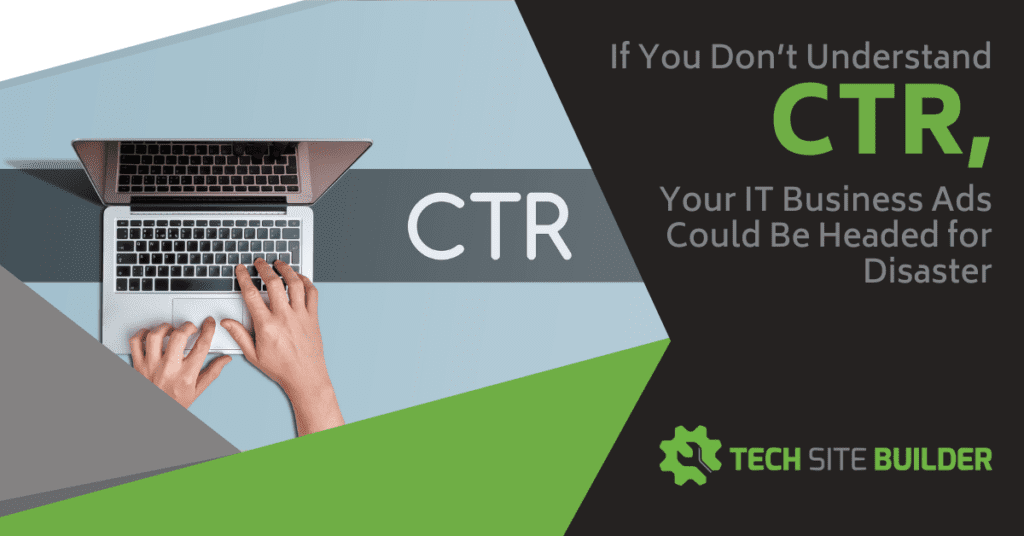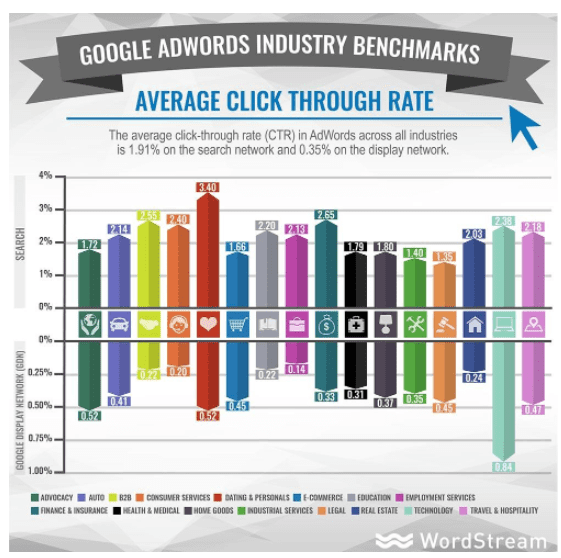
There are several important metrics to take in when doing content marketing, and one of the most important for your paid ads is click-through rate (CTR). If you don’t fully understand how to read this, your efforts could be doomed.
Not reading your CTR properly or paying attention to it at all can lead you to pay way too much for visitors to your website. It can also cause you to spin your wheels and never gain any real traction from your pay-per-click (PPC) ads.
Have you wanted to get a better handle on what CTR is and how to apply it to make good marketing decisions? Read on for a full breakdown of the click-through rate and how to use it!
Click-Through Rate Definition
Understanding the calculation of CTR isn’t hard, it’s applying the mechanics of CTR to guide your ad copy and keyword choices that can be tricky.
Google defines click-through rate (also written as clickthrough rate) as:
“A ratio showing how often people who see your ad or free product listing end up clicking it.”
CTR is the number of times your ad is clicked divided by the number of times your ad is shown (clicks ÷ impressions = CTR). So, if you have an ad that is shown 1,000 times to people on Facebook and 100 people clicked on that ad when they saw it, the ad would have a 10% CTR.
CTR can be related to:
- An ad
- A keyword
- A paid or free product listing (e.g., through Google’s Merchant Center)
Where Do You Find Click-Through Rate?
Click-through rate will typically be found in your analytics reports within Google Ads, Facebook Ads, LinkedIn Ads, or another PPC platform.
You can also find CTR in Google Analytics if you’ve connected your Google Ads account to your analytics.

What Should My Click-Through Rate Be?
The average click-through rate that’s considered “good” can vary according to industry and the product or service being sold. Across all industries, the average CTR is 1.91% on the regular search network and lower on the display network (0.35%)
According to WordStream’s CTR chart, there are a few targets for IT business providers to shoot for, depending upon your target markets and who you are advertising to in your paid ads.
I’d recommend MSP providers and IT businesses compare their CTR with:
- B2B Businesses: Search network: 2.55% CTR, Display network: 0.22% CTR
- Consumer Services: Search network: 2.40% CTR, Display network: 0.20% CTR
- Technology: Search network: 2.38% CTR, Display network: 0.84% CTR

Chart credit: WordStream
What’s the difference between the search network and the display network?
The search network is when your ads appear on a Google.com search result page along with the organic listings.
The display network is when your ads appear on other websites, not directly related to a search. Because users aren’t actively searching using a keyword when they run across your ad, the CTR is typically much lower than for the search network.
Understanding Your Ad Click-Through Rate
Just looking at a CTR and thinking “higher must be better” could cause you to pour a lot of advertising dollars down the drain without any sales to show for it.
CTR is just one of the metrics you need to consider, so it should be reviewed along with other important metrics like bounce rate, for example.
We’ll go through several ways to understand and glean valuable information from your advertising click-through rates so you can improve your sales and lead generation efforts.
Why a High CTR Is Usually (But Not Always) Good
On a basic level, a high CTR is good. It means that a good number of people that see your ad are interested enough to click on it.
When you have a low CTR it can mean that your ad message isn’t connecting with people. Maybe you’re using boring text that isn’t compelling. Or possibly you could be using an image that isn’t attractive to your target audience.
It can also mean that your keyword choice is wrong for your message.
For example, say that you’re advertising Smart Home Setups and believe you have a great ad with compelling copy. If you are using a keyword such as “home entertainment,” you could be going way too general and a majority of those people aren’t searching for help with smart home technology at all. They could simply be looking to buy a Roku or Fire TV Stick device, so they ignore your ad.
Having a CTR above your industry average can mean that you’re doing a great job at connecting with your audience unless you’re not seeing an increase in leads or sales as a result.
In this case, a great CTR can mean you’re spending money on all those clicks but they’re not converting properly to leads. This is why CTR is not a stand-alone metric. It needs to be looked at alongside other KPIs.
Look at CTR + Number of Impressions
You look at your Google Ads report and see a low CTR for your ad. Should you immediately jump into action to change your ad copy? Not quite yet, first, you should look at your number of impressions (i.e., how many times your ad is shown to people).
If you have a low number of impressions, it can mean that your ad isn’t being shown enough to get a higher click-through rate.
Reasons for a low number of impressions are:
- You’re bidding too low
- You use keywords that aren’t used very often
- You have a low quality score causing your ads not to be shown
Before you go changing your entire ad campaign, you would want to ensure you have a decent number of impressions so you can fairly gauge CTR.
Look at Click-Through Rate + Sales/Leads
No matter what business you’re in, the measure of success for a digital ad campaign is how many leads and sales are being generated.
One frustration that many business owners have with some flashy PPC and online marketing companies is that they offer several other metrics like click-through rate, time on page, etc., but don’t directly speak to sales generated.
A good CTR is only as good as the lead and sales that are generated for your MSP business. So, you want to ensure that you are tracking conversions. You can find tips on setting up conversion tracking in Google here.
Look at Click-Through Rate + Bounce Rate
Your bounce rate is how many people visit one page on your site and never venture through to another page. If you only want then to visit one page, then a high bounce rate won’t bother you. But most business owners want customers to engage with their site, maybe check out a service page, visit the contact form, etc.
If you have both a high CTR and a high bounce rate, that could indicate your ad dollars going down the drain and your marketing campaign is being tanked due to a website or targeting issue.
For example, if you promise someone “great managed antivirus” in your ad, but land them on a page that says “managed backups” at the top, they’re bound to leave and go to the next search result.
If you have a high bounce rate and are finding that you aren’t getting good results from your paid online ads, here are a few things to consider:
- Your page load time could be too long.
- You may be landing people on a page that doesn’t match the ad copy.
- You could be landing people on a page that’s too general, like “home.”
- Your page may not be optimized for conversions with a strong call-to-action.
Dig Into the Difference Between Ad CTR and Keyword CTR
Keywords will have different click-through rates than ads. Digging into both CTRs can help you fine-tune your advertising to reduce costs and get better results.

For example, if your ad has a great CTR of 3.5%, but you find that one of the main keywords you’re using has a CTR of only 0.2%, that’s an indicator that while your ad may be good, it’s not targeted well to that particular keyword.This is a clue that you may want to create a slightly different ad that is better matched to that keyword to improve its performance.
Here’s an example:
You have an ad that says, “Excellent Remote Worker IT Support – ABC Tech is there for you with 24/7 help”
You find that one of your keywords “remote worker security” isn’t doing as well as the other keywords. For some reason, it has a much lower CTR.
Try adding a second ad, just for that and any related keywords that says, “Excellent Remote Worker IT Security – ABC Tech is there for you with 24/7 protection.”
Sometimes, just a few slight changes to your ad copy to better match a keyword can make a big difference in getting people to click on your ad.
Look at Click-Through Rate + CPC
CPC stands for cost-per-click, and this is a vital metric to look at along with CTR. If you increase your bid price so your ad is more prominently displayed, it can increase your CTR, BUT it can also increase your CPC, the amount you pay for each click on average.
You don’t want your CPC to get higher than is reasonable for your profit margin. For example, if you’re advertising a service that costs $30, and you have a CPC of $10, it could be costing you more to advertise than it’s worth, because all those clicks won’t translate to sales, so you’d likely be losing money.
You need to balance the number of impressions your ad is receiving, thus the CTR it can achieve, with the cost you’re paying for each of those clicks so it’s making sense for your bottom line.
Address Reasons for Low CTR
How do you fix a low CTR? As you can see from the stats we’ve discussed above, there can be many reasons for a low click-through rate. But, if you want your digital ad campaigns to achieve your desired results, it’s important to take the time to look at your various metrics.
Here are some of the reasons for low CTR:
- A low number of impressions: Fix by either improving Quality Score or increasing your bids.
- Poor match of keywords to ad copy: Create more ad campaigns to better match ads to keywords.
- Poor match of ad copy to landing page text: Tailor landing pages with your ad campaign in mind.
- You’re targeting the wrong audiences: Take advantage of detailed targeting by audience demographic that’s available in ad platforms.
- Boring ad copy: Work with an MSP marketing firm to help energize your ad text.
- Bad quality ad image: Use image best practices when choosing ad images.
- You’re not bidding enough for a good position: Work out your optimum cost-per-click, and if competition is too stiff, revisit your keyword selection.
When You Master CTR, You Improve Your Digital Ad Performance
Understanding and mastering the click-through rates of your online ad campaigns can help you fine-tune your marketing engine and get better results and more sales.
Do you have any questions about CTR? Share them in the comments and we’ll do our best to give you a good answer.
Speak Your Mind